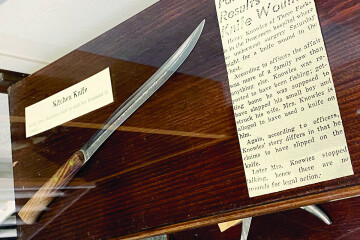Capturing the Homesteaders’ Spirit
When I look around at Bozeman now, it is hard to imagine what it was like a century ago. However, the minute I venture to the mountains or plains, I can sense the overwhelming immensity that must have greeted early Montana homesteaders. The prospect of so much land on which to grow crops, graze livestock, and establish a life must have been invigorating, yet the blustering wind, wild animals, and uncertainty that comes with uncharted territory must have been occasionally terrifying. Homesteaders were adventurers at heart, eager to try something new and willing to live under the threat of crop failure or the return of Native Americans rightfully seeking to reclaim land that had been stolen from them. Artist Carol Hartman beautifully captures this dichotomy of fortunes both good and bad in her series of oil paintings depicting early Montana homestead life.
Hartman’s homestead paintings are as immense as the Montana prairie, both in artistic grandeur and physical size. The 48” X 48” oil paintings are being displayed in the Weaver Room Gallery in the Emerson Center until August 26. The exhibit, titled Challenges, displays some of the paintings in Hartman’s “Homestead” series. Though this exhibit has been shown in many places, from Sidney, MT (Hartman’s hometown) to New York City and Florence, Italy, bringing it to Bozeman is a sort of homecoming. She is a graduate of Montana State University, and has been painting full time in Montana for the past six years. She has travelled throughout the state and northern plains retracing the steps of early homesteaders as she worked on her paintings.
For the past three years, Hartman has travelled Montana seeking the old homesteads of her ancestors and their fellow community members. She uses old census maps, early photos, and the help of family and friends to find the locations she’s looking for. It’s been an adventure that included tearing the engine guard off of her car while driving through Montana prairies and, more importantly, an Artist Residency at the Homestead National Monument in Nebraska. This residency was “a valuable influence on understanding the courage of the homesteaders and their interaction with the Native Americans who were already in the area,” Hartman said in a recent press release. “My intention is to create an environment of discussions about homesteading practices and the political climate of the time.”

And, what a time it was! Once the Homestead Act passed in 1862, people flocked to the West for the promise of free land. However, the trip itself was arduous, and many didn’t make it. Those that did met with widely varying degrees of success. Some got lucky and found fertile farmland in river bottoms, but more found arid, unproductive grassland that made survival extremely difficult. The fight for waterfront property was intense and the losers were faced with a struggle to put food on the table. Some even struggled to build homes because timber in many areas was scarce. These stories of struggle and survival influenced the Montana we know today in a multitude of ways.
The Homestead Act, and later the Enlarged Homestead Act, encouraged the population of the West during a time when our country was in turmoil. Abraham Lincoln signed the act into law after the southern states seceded the Union. The Civil War had begun and many were probably smart to head West and escape the bloodiest chapter of America’s history. Anyone considered the head of a household was eligible to claim land, build a home there, and work the land. Any homesteader able to stay in place for five years was given the title to their land for a small fee.
In many ways, the land was shocked by the influx of people and livestock. Montana homesteaders and farmers were encouraged to increase production after World War I, but the droughts of the 1920s made this almost impossible. The overgrazing that occurred during this time decimated the native Bluebunch Wheatgrass, an issue that scientists are still working to remedy to this day, according to the State of Montana. The Great Flu Pandemic of 1918-1919 sickened thousands of Montanans, according to the United States Department of Health and Human Development, making it even harder for homesteaders to succeed on their claims. Many of Montana’s original homesteaders left, but those that stayed gave their tenacious spirit to their descendants.
A significant number of homesteaders were single women. Anna Scherlie filed a claim for her land in 1913 when almost 25% of people filing for homestead applications were women. She built a small wooden shack and worked her land until 1968. Scherlie’s homestead shack has been nominated for listing on the National Register of Historic Places. The pioneer spirit she shared with other homesteaders surely influenced social attitudes past and present. For example, women in Montana won the right to vote six years before the U.S. Constitution allowed women across the country this same right. Individuals, like Scherlie, who came to Montana and refused to give in to hardship influenced the attitude of independence we see in Montana today.
This homesteading spirit also influenced Hartman’s work. Her paintings capture the opportunity and hardship endured by so many homesteaders in vivid color. Her depiction of dark clouds moving in over a homesteader’s shack embody the fear and uncertainty that must have been a regular part of life; yet, her depictions of a riverside church and sun breaking through the clouds make palpable the hope of opportunity that homesteaders experienced.
Hartman’s work is on display at the Emerson through most of August. She will hold a reception on Friday, August 12 from 5p.m. to 8p.m. Whether you make it to the reception or go on your own time, viewing her beautiful work and reflecting on how our forefathers managed this land during difficult times is absolutely worthwhile.



